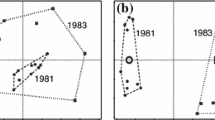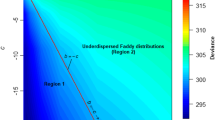Abstract
Transformation is required to achieve homo-scedasticity when we perform ANOVA to test the effect of factors on population abundance. The effectiveness of transformations decreases when the data contain zeros. Especially, the logarithmic transformation or the Box–Cox transformation is not applicable in such a case. For the logarithmic transformation, 1 is traditionally added to avoid such problems. However, there is no concrete foundation as to why 1 is added rather than other constants, such as 0.5 or 2, although the result of ANOVA is much influenced by the added constant. In this paper, I suggest that 0.5 is preferable to 1 as an added constant, because a discrete distribution defined in {0, 1, 2, . . .} is approximately described by a corresponding continuous distribution defined in (0, ≧) if we add 0.5. Numerical investigation confirms this prediction.
Similar content being viewed by others
Author information
Authors and Affiliations
Additional information
Received: October 16, 1998 / Accepted: June 10, 1999
Rights and permissions
About this article
Cite this article
Yamamura, K. Transformation using (x + 0.5) to stabilize the variance of populations. Res Popul Ecol 41, 229–234 (1999). https://doi.org/10.1007/s101440050026
Issue Date:
DOI: https://doi.org/10.1007/s101440050026




